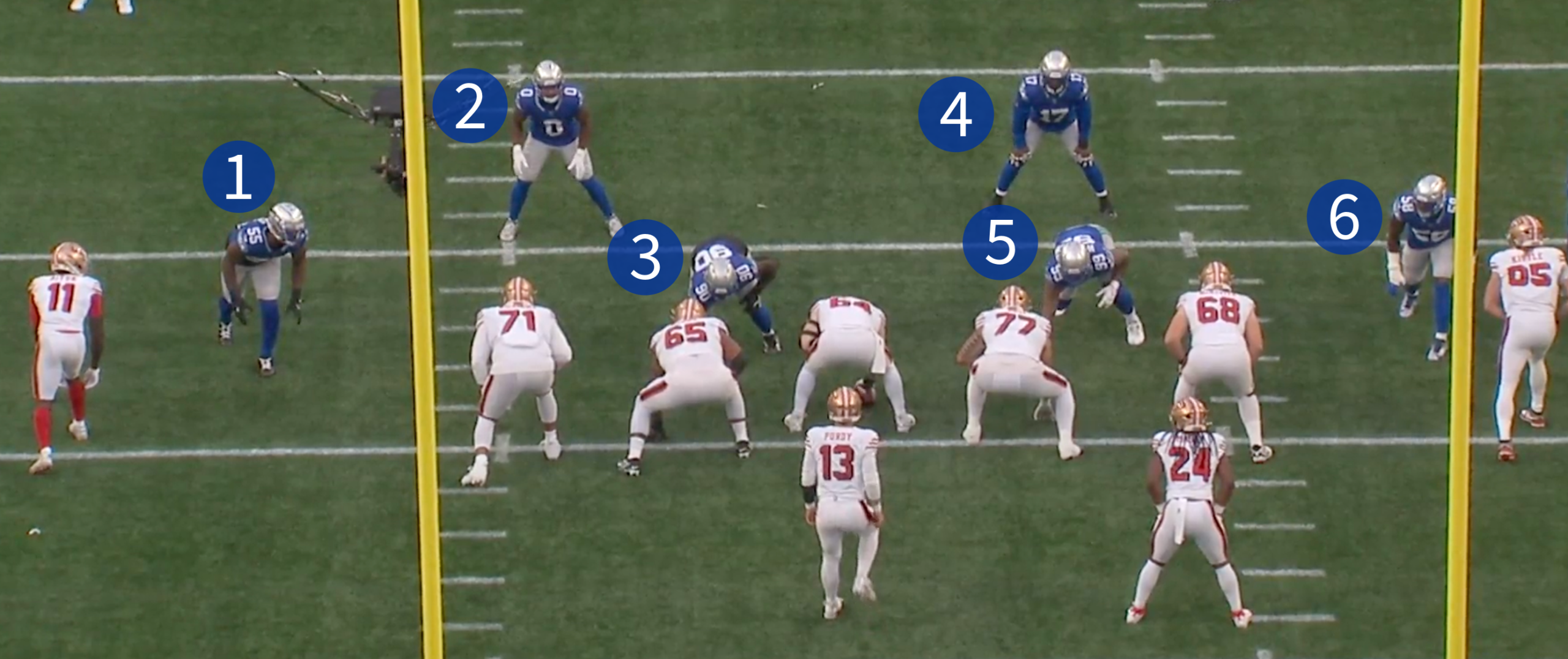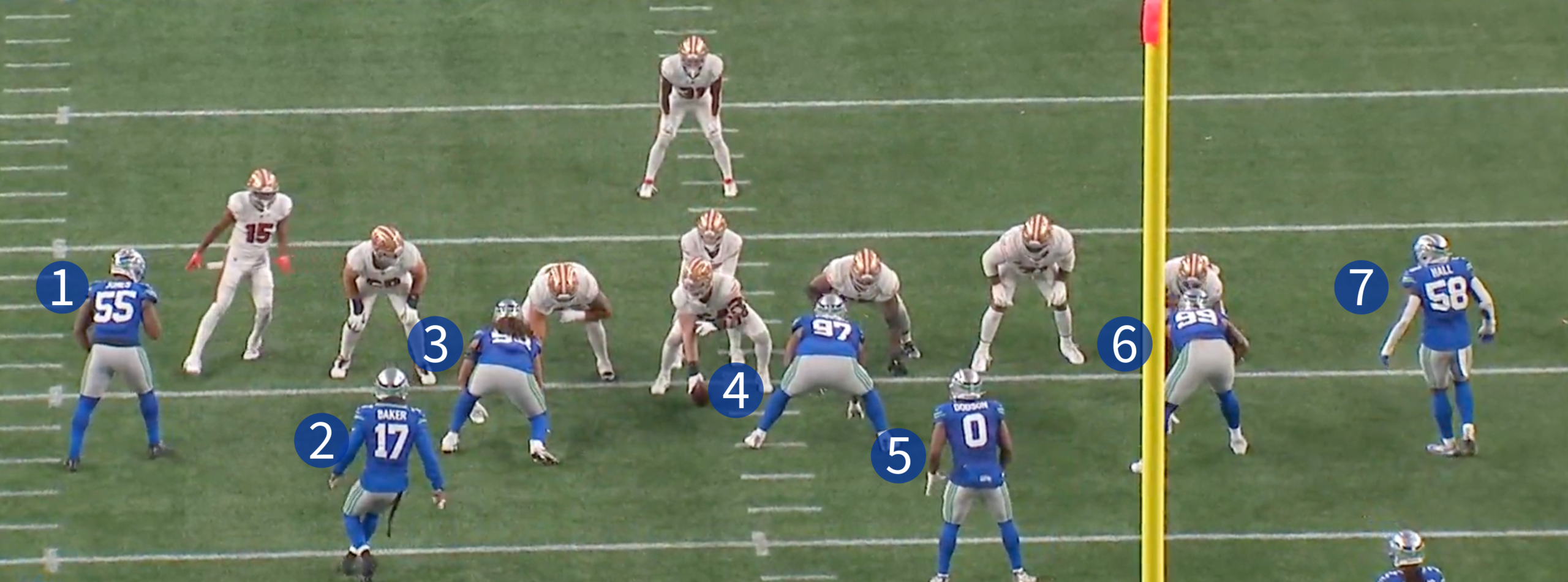Opponents running all over the Seahawks defense has become an annual tradition that fans would love to stop. Seattle ranked 30th in rushing yards allowed in 2022 and 31st in 2023. They currently sit at 27th, but coming off a two-game stretch where they allowed an average of 201.5 yards per game on the ground has many fans feeling like they will once again be tortured by embarrassing performances against the run. Hidden beneath the gore of the few weeks are some signs that better days could be ahead.
Boxed in
The simplistic view of run defense is that it is simply a matter of which team is more physically dominant. That can definitely be a big factor. But even that warrants a little extra examination.
Seattle entered this season trying to lean heavily on a light box approach to stopping the run. A light box is when the defense has six (or fewer) defenders near the line of scrimmage before the snap. This typically means you have one fewer defensive tackle (2 instead of 3).

Mike Macdonald and many defensive coaches are trying to get away with more light boxes so they can have an extra defender available in coverage to slow down these prolific passing offenses. The problem is doing that leaves one less defender to stop the run. Giving up run yards in this situation is somewhat expected.
There are a certain amount of gaps that an offense can attempt to run through on any given play. One less defender in the box means defenders have to cover more gaps. This is especially challenging for linebackers, who must pick the proper gap to plug while often dealing with big offensive linemen running right at them.
Seattle has struggled with light box run defense much of the year. They rank 29th in the NFL in yards per carry allowed (6.1) when in light box. That’s actually worse than the prior two seasons when they ranked 17th in 2022 (5.0 YPC) and 21st in 2023 (5.2).
Believe it or not, Seattle had one of its best games in run defense while in light box against the 49ers.

You will not hear any of the Seahawks coaches or players touting “progress” in a game where they surrendered a season-high in rushing yards, but the team held the 49ers to 4 yards or less on 5 of the 7 light box rushes in that game. They did, however, still give up one explosive rush when Jordan Mason ran for 14 yards. On the year, 11 of the 21 explosive rushes have come against light box.
Enter neutral box. Neutral box means you have seven defenders in the box. The reason it is considered neutral is you are neither biasing toward run or pass defense. In the modern game where passing is such an emphasis of most offenses, you could argue a neutral box is a bit more biased toward run defense. It depends a bit on which seven players you have on the field.

Seattle deployed neutral box more than light box for the first time all season in the Thursday night game. This represented a coaching adjustment, and is probably as much about recognizing what the Seahawks had done well and where they had struggled in the previous five weeks.
Seattle was top 5 in the NFL against the run in neutral box entering Week 6. Unlike light box, that is a massive improvement over what the Seahawks had done in previous seasons. Seattle ranked 31st (5.5 YPC) in 2022 and 27th (4.6 YPC) in 2023.
You might assume the 49ers crushed Seattle on the ground in neutral box given all their rushing yards. That would be incorrect. Seattle allowed just 4.1 yards per carry and 0 explosive rushes when playing a neutral box.
They are 7th in the NFL on the season, allowing just 3.8 yards per carry when in neutral box on the year. Part of the change to expect from the Seahawks going forward is more neutral box leveraging three defensive tackles. They did it against San Francisco and it showed promise despite the ugly totals.

More beef
Neutral box does not mean you need to play three defensive tackles. In fact, Seattle often will have two outside linebackers on the field like Boye Mafe and Derick Hall or Dre’Mont Jones. This was another subtle shift in Week 6, which was to have three down linemen on the field more often. They played more classic 3-4 looks as well where they had three down linemen and a heavy outside linebacker in Jones opposite the also physical Hall.

One of the challenges of running more neutral box with three defensive tackles is the big guys tend to wear down. That issue has been exacerbated by the injury to Byron Murphy, and the poor play of backups Mike Morris and Myles Adams, which forced Jarran Reed (82%) and Leonard Williams (91%) to play season-highs in snap count percentages against SF, while also asking Johnathan Hankins to nearly double his play rate.
This leaves the team open to wearing down over the course of the game and is not sustainable across a season.
Enter Roy Robertson-Harris and Murphy. Robertson-Harris will immediately take all the snaps that were going to Morris or Adams, and will also spell Reed and Williams. Murphy can play all across the line, including at nose tackle in place of Hankins.
Murphy was playing 55-60% of the snaps when he was healthy. He was also playing at a high level. Robertson-Murphy is far more physical than either Morris or Adams. He may even be more stout than Reed. Where he ranks is less important than the fact that he is a player who has made a good amount of money by being very hard to move at the line of scrimmage. He has a wicked straight arm that bends offensive linemen backwards.
Murphy is also not your typical defensive tackle. Aden Durde said as much today.
“I think he has the ability to split the double team,” Durde said. “He has the ability and the power to push that pocket. A lot of people once they hit a double team, they stop and try and balance the rush of that. Byron (Murphy II) has the ability and lower strength to split that, and I’ve only seen a couple of guys that can do that.”
Add two talented and physical players to the defensive line and good things tend to happen. Not only will they make plays, but they can lift the play of others around them by giving them additional rest and demanding more attention.
It also means Jones, who was asked to slim down this year to play outside linebacker, can return to that assignment instead of being asked to be an undersized defensive tackle.
The fact that the Seahawks are 3-0 when Murphy has played and 0-3 when he has not is mostly coincidental, but not entirely.
Sharpen the edges
Macdonald has talked about the importance of the defensive line staying square at the line of scrimmage in run defense as step one, and setting the edges as step two. Seattle was doing a great job of that to start the year when they had a healthy Mafe, Hall, and Jones.
Mafe is known as a great pass rusher, but he is also extremely productive against the run. He went from playing nearly 90% of the snaps in week 1 to playing just 23 snaps in the last three games, including missing two of the three.
The hope is the extra rest following a Thursday night game will help him get closer to full strength.
Hall also was battling an injury leading up to the 49er game, but toughed it out. Those two players were among the top ten in run stop win rate for edge players to start the season. Their health and availability will be a significant factor in plugging the leaks in the run game.
Time and practice
Inside linebacker play has been a problem, especially the last three games. There have been multiple moments where a linebacker has jumped out of the gap they were responsible for or made the wrong read and left running backs with wide open lanes to gain big yards.
Some of this is due to poor instincts. Some of it is due to players getting acclimated to the new scheme. And some of it is lack of chemistry. No coach or player will use it as an excuse, but the last two games was the first time Tyrel Dodson and Jerome Baker have played two full games together.
Baker missed OTAs and training camp, robbing him and Dodson of valuable time to work out the kinks of what can be a complex defense, especially for linebackers.
The issues that popped up in the Giants game are best addressed through padded practices where you get the closest approximation to game reps in defending the run. Seattle went two weeks without a padded practice due to the schedule crunch of 3 games in 11 days.
The first time Baker and Dodson had a chance to work through their issues together on the practice field in pads was Wednesday of this week.
Many fans seem to have already given up on this duo at linebacker. That feels premature. Coaches have now had a chance to see these repeated issues and identify them for the players. The players have seen them and now have an opportunity to work on them.
Consider that some of those issues were amplified by Macdonald calling more light box alignments that cause more stress on the linebackers to cover more gaps and less effective defensive line play that allowed more free runners to block the linebackers. There is now the potential for there to be fewer of those high-stress scenarios, more dominant line play, and improved recognition and discipline.
Where there were compounding issues wreaking havoc on the run defense, we may be headed toward the opposite set of factors leading to a dramatic improvement.
Words and numbers do not matter if the opponents continue to run the ball against Seattle. Macdonald has been correct in saying there have been new problems in these games that are leading to the nauseating rushing totals. The new challenge this week will be the loss of his starting safety in Rayshawn Jenkins, who has been used heavily in run defense. Macdonald has to hope that his front seven is in a much better place to contain the run while requiring less of his safeties in run support.
The recipe is there. More neutral box. More beef in the box. Better quality beef. Improved decision-making due to time and practice. Atlanta represents a terrific test. Where most Seahawks fans are feeling traumatized by seeing what has appeared to be the same hopelessly bad run defense they have watched for years, there is reason to believe this group can build on things they have already been doing well and make this a defense fans look forward to watching.
